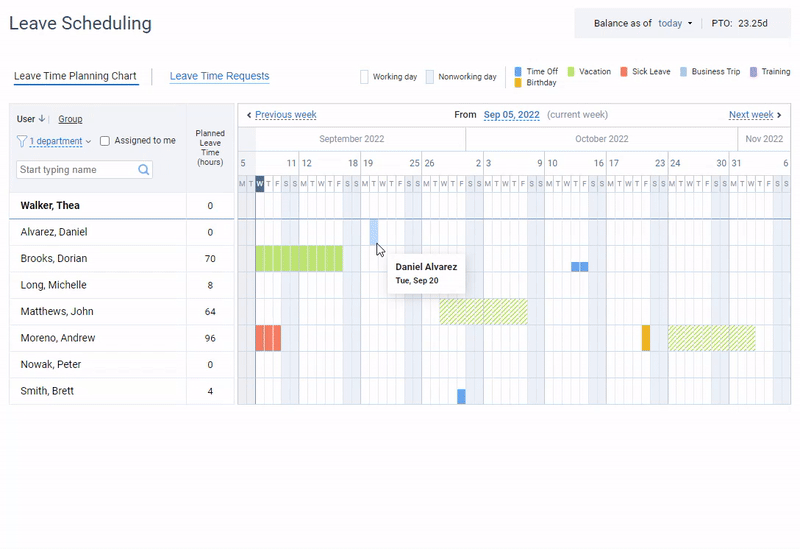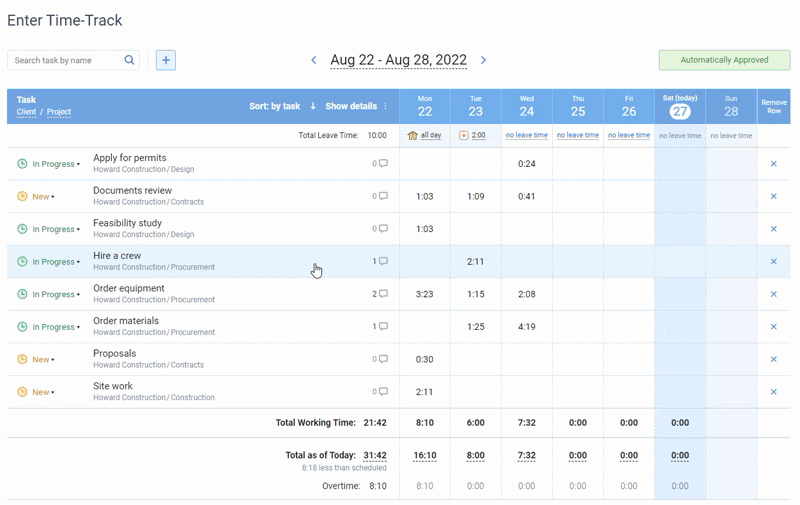The regular 40-hour work week is gradually becoming a thing of the past – compressed work schedules and flexible schedules are now taking over. A 9/80 work schedule is one of the possible compromises between working 40-hour work weeks and introducing flexible hours, because it offers two days off every month without spending PTO balances.
Read on to learn how the 9/80 work schedule works, how to manage it effectively and whether your business can benefit from this work arrangement.

What Is a 9/80 Work Schedule?
A 9/80 work schedule is a type of compressed work schedule that divides 80 working hours amongst 9 days. Unlike the standard 40-hour work week, the 9/80 work schedule allows to do 80 hours of work in 9 days instead of 10 days and have a day off.

The goal of a 9/80 work schedule is to increase productivity and help employees maintain a better work-life balance.
How Does 9/80 Work Schedule Work?
The idea of a 9/80 work schedule is simple. You take two-week periods, pick a day off and spread the working hours across the rest of the working days.
Typically, companies break the first week into four 9-hour and one 8-hour working days and the second week into four 9-hour working days and one day off. As a result, employees work two 40-hours workweeks and have a day off:
Week 1: 9 + 9 + 9 + 9 + 8 = 44 hours worked
Week 2: 9 + 9 + 9 + 9 = 36 hours worked + a day off
Total: 80 hours worked
How to Run Payroll For 9/80 Work Schedule
A 9/80 work schedule results in 4-hour of overtime in the first week (44 working hours) and 4-hour of underwork (36 working hours) in the second week. If you don’t want to make this schedule arrangement affect payroll calculations, use the following approach.
Track working hours in two-week periods where the first Friday, which is usually an 8-hour workday, is divided into two parts: the first 4 working hours mark the end of the first week and the rest 4 working hours mark the beginning of the second week. This way, you’ll have two 40-hour work weeks.

How To Manage Leaves For 9/80 Work Schedule
The 9/80 work schedule also affects the way you handle sick leave days and vacation days. A sick day on a 9-hour work day results in 9 hours of sick leave time. The same goes for vacations and other types of leaves: all leaves of absence count as 9-hour days except for the first Friday of the two-week period, which is an 8-hour day.
Holidays are also affected. If a holiday falls on a 9-hour work day, it is split into an 8-hour holiday and a 1-hour vacation. If a holiday falls on the scheduled day off, the employee receives 8 hours off to be used for the next 12 months from the date of the holiday.
How To Calculate Overtime For 9/80 Work Schedule
Calculating overtime for 9/80 work schedules is rather complicated. Remember the way we divide the two 40-hour work weeks on Friday of the first week? Working for more than 40 hours before noon on Friday results in overtime. The same is then true for the following week.
Pros & Cons Of 9/80 Work Schedule
Employers introduce flexible work schedules because they bring benefits to businesses and employees. At the same time, they pose challenges because they are unknown to businesses and employees who know no other work arrangements other than standard 40-hour work weeks. Should you trade your standard work week for the following 9/80 work schedule benefits – review this list to find out.
Advantages
The following list outlines 9/80 work schedule advantages for businesses and employees:
Business advantages:
- Attract better talents. A 9/80 work schedule can become one of the many employee benefits and perks.
- Improve employee productivity. Employees who feel comfortable working a 9/80 work schedule will be more productive due to more work satisfaction and less interruptions between the tasks.
- Reduce absenteeism. Sometimes employees take sick leaves for personal reasons, e.g. to go out of town or go to an appointment. If they have a day off every two weeks, they might abuse sick leaves less often.
Employee advantages:
- Better work-life balance. Having two day off every month can contribute to job satisfaction and better balance between work and personal life.
- Less commutes. Extra two days off every month guarantee less time commuting, associated stress and expenses.
Disadvantages
9/80 schedules don’t fit every employee and every business and there are solid reasons for that.
Business disadvantages:
- Not suitable for every industry. Knowledge-based workforce has higher chances to accommodate a 9/80 work schedule compared to manual labor and service industries.
- Tricky leave management. A day of sick leave equals 9 hours unless it is taken on the 8-hour day, which makes leaves difficult to manage.
- Time tracking challenge. No time tracking system is flexible and customizable enough to help you manage Fridays that contain working hours for two different work weeks.
- Schedule that is hard to manage. If an employee wants to have their day during the first week (from Monday to Friday noon), this will result in overtime on the first week and underwork during the second week.
- Staffing gaps. Small companies usually don’t have enough staff to cover for employees working 9/80 who are absent every second Friday.
Employee disadvantages:
- Decreased employee productivity and satisfaction. Most employees are likely to struggle with the additional hour each day. They might feel like they no longer have spare time after work and become less satisfied with their job.
- The longer workday may be physically and mentally draining. Exhaustion and burnout cases might become more common in your team.
Will Your Business Benefit From The 9/80 Work Schedule?
Before you introduce a 9/80 work schedule in your company, consider the following:
- Is your team interested in an alternative work schedule? Discuss it with your employees and management before you introduce the change.
- Do local and state laws pose any limitations? They may require you to pay overtime pay to employees working for more than 8 hours per day.
- Do you have enough resources? Do you have enough human resources to create optimal shifts? Do you have enough funds to cover overtime expenses if they happen?
- How is it going to impact your customers? Will they benefit from longer business operation hours? Can you cover for time offs to provide sustainable customer service?
- Do you have a reliable time tracking system in place? To manage a 9/80 work schedule effectively, you need to get your employees to track their working hours daily.
- Do you have leave management software in place? Managing employee attendance, absences and leave balances will get much trickier with the 9/80 work schedule. Do you have a flexible absence management system to rely on?
If you are not sure if the 9/80 work schedule is a good fit for your business, consider testing the schedule on a control group to find out.
How To Manage Alternative Work Schedules?
Alternative work schedules require a more flexible approach to managing employee time, workload, absences, leave balances and payroll. While your employees might enjoy these schedules, your managers, accountant and HR team might not be as happy about it as they face new challenges in day-to-day operations. To help them manage, you need to introduce a reliable time and absence management system that can take most of their work and automate most of the processes.
For example, actiPLANS is a leave management system that boasts custom leave types and automated absence management.

Leave management in actiPLANS – create an unlimited number of leave types, get your team to request and plan their time off and review employee availability
and its integration with actiTIME – a time and project management system. Imagine if you could set up custom work schedules, distribute the workload, get your team to register their attendance and time across activities and review their working hours, attendance and absence in a single system – actiPLANS integration with actiTIME can do that.

they want to see in their timesheets
Give it a try – request a free 30-day trial to see if it’s a good fit for your business (no credit card required).




